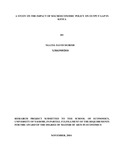| dc.description.abstract | In developing countries serious output challenges persist to date. Most countries operate far
below the optimal output path. This can be rationalized by the nature of the macroeconomic
policies in place. This study reviews the impact of macroeconomic policies on output gap in
Kenya. The study focuses is on the various methods of generating the output gap with bias
towards output gap obtained using the Hodrick-Prescott filter. Estimation of an output gap model
helps inform the importance of both the fiscal and monetary policy and which one among them is
dominate the other. The study finds that monetary policy appears to be more effective in
reducing output deviations from its potential levels. However, fiscal policy on the other hand
appears to increase the output gap. The study thus recommends the need to have increased
coordination of both the fiscal and monetary policy. In addition, the policy makers should utilize
expansionary monetary policies to lower the output gap. Further, regulation of the government
expenditure could ensure that funds are only channeled towards productive investments.
The data was gathered from secondary sources and mainly from Kenya National Bureau of
Statistics | en_US |

